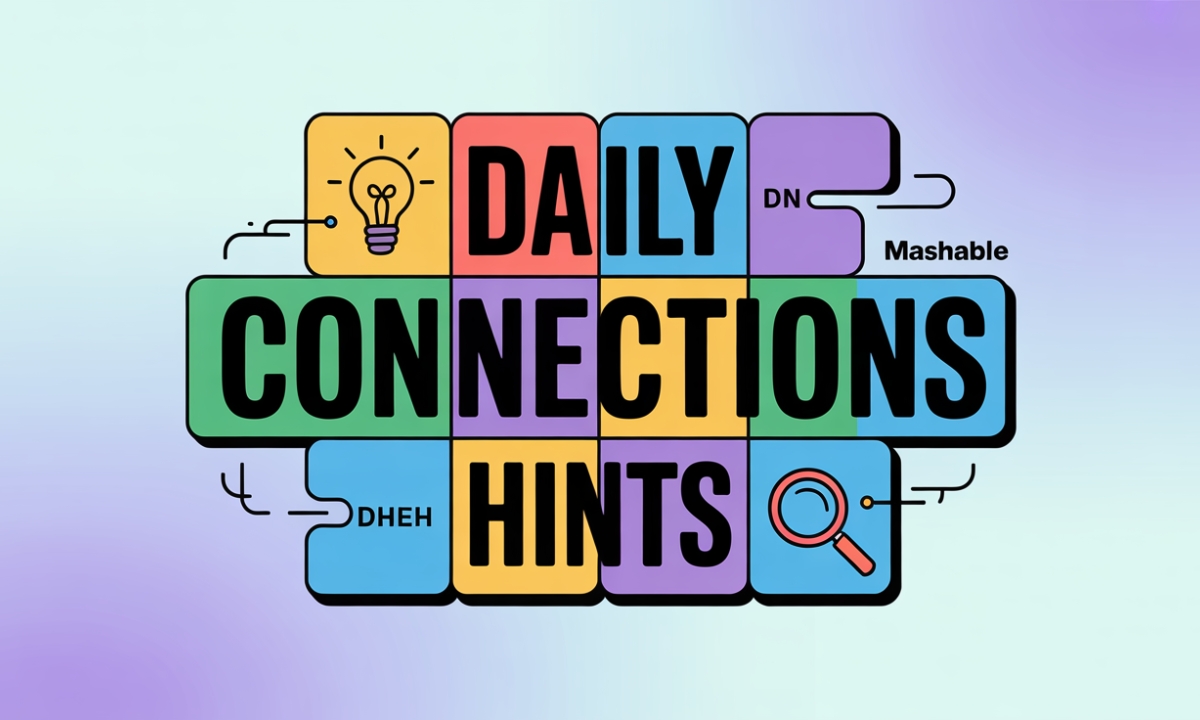The alarm buzzes at 6 AM. Coffee’s brewing, and you’re already reaching for your phone. Not for emails or social media—for today’s NYT Connections puzzle. Those 16 seemingly innocent words stare back at you, daring you to find the hidden patterns. Sound familiar?
You’re not alone. Over 2 million people start their day with this exact ritual, and a growing number turn to Mashable connections hint resources when those connections feel impossible to crack. The puzzle that seemed simple in concept—group 16 words into four categories—has become a daily obsession that combines the satisfaction of a completed crossword with the strategy of chess.
This phenomenon isn’t just about word games anymore. It’s about daily connections hints becoming part of our morning routine, puzzle-solving mastery as a badge of honor, and communities forming around shared frustration and triumph. Whether you’re a newcomer struggling with your first week or a seasoned solver looking to maintain your streak, understanding how to leverage hints effectively can transform your puzzle experience.
H1: Mashable Connection Hint Today– Daily Hints & Answers
Mashable connections hint resources have revolutionized how we approach daily word puzzles. Gone are the days of staring helplessly at scrambled letters or abandoning puzzles mid-solve. Today’s hint platforms offer sophisticated guidance that preserves the challenge while preventing complete defeat.
The magic lies in strategic hint consumption. Rather than simply providing answers, quality hint resources like Mashable offer layered assistance. You might start with category themes, progress to word association clues, and only resort to specific answers when absolutely necessary. This approach maintains the puzzle’s educational value while ensuring you can participate in the daily cultural conversation.
Daily connections hints serve multiple purposes beyond mere problem-solving. They function as learning tools, helping solvers recognize patterns they’ll encounter in future puzzles. They build confidence for newcomers who might otherwise abandon the game entirely. Most importantly, they create a bridge between complete independence and total surrender—a middle ground where growth happens.
The key to effective hint usage lies in timing and restraint. Experienced solvers often set personal rules: try for 10 minutes independently, then consult category hints, wait another 5 minutes before seeking specific guidance. This structured approach maximizes learning while preserving the satisfaction of discovery.
H2: What Makes NYT Connections So Captivating?
The Perfect Storm of Challenge and Accessibility
NYT Connections has achieved something remarkable in puzzle design: the perfect balance between challenge and accessibility. Unlike crosswords that require extensive vocabulary or Sudoku that demands mathematical logic, Connections relies on pattern recognition—a skill everyone possesses but few have truly mastered.
The genius lies in its deceptive simplicity. Sixteen words arranged in a grid look manageable. Four categories of four words each seems straightforward. Yet the puzzle creators have mastered the art of misdirection, creating connections that feel obvious in hindsight but remain elusive during solving.
Research from puzzle psychology experts reveals why this format proves so addictive. The cognitive load balance provides enough complexity to challenge without overwhelming. Pattern recognition reward systems trigger dopamine release when connections click. The social proof element creates community engagement through shareable results. Completion satisfaction offers clear victory conditions unlike open-ended puzzles.
The color-coded difficulty system adds another layer of psychological sophistication. Yellow categories provide early wins that build confidence. Purple categories offer challenges that separate casual players from dedicated solvers. This progression creates a natural learning curve that keeps players engaged across skill levels.
Social Media Phenomenon and Sharing Culture
The colored square sharing system has transformed NYT Connections from a solitary activity into a social phenomenon. Those familiar grids flooding your Twitter feed aren’t random—they’re sophisticated social signals that communicate puzzle-solving prowess without spoiling answers.
Community solving has emerged as a natural extension of this sharing culture. Friends compare strategies, families compete for daily victories, and online communities dissect particularly challenging puzzles. The shared struggle creates bonds that transcend the puzzle itself.
Mashable connections hint platforms have become central to this social dynamic. They provide common reference points for discussion, offer neutral ground for seeking help without admitting defeat to friends, and create educational resources that benefit entire communities.
Daily Ritual Formation and Habit Psychology
The daily release schedule taps into powerful psychological mechanisms around habit formation. Unlike puzzles you can binge-solve, Connections creates anticipation and routine. Players often report that checking their daily puzzle has become as automatic as checking weather or news.
This ritual aspect explains why daily connections hints have become so popular. They’re not just problem-solving resources—they’re part of the daily routine that keeps players engaged even when puzzles prove particularly challenging.
Streak psychology plays a crucial role here. The fear of breaking a solving streak drives many players to seek hints rather than skip difficult puzzles. This behavior pattern has created a thriving ecosystem of hint resources, with Mashable leading the charge in providing thoughtful, educational guidance.
H2: Leveraging Mashable Connections Hints Without Spoiling Fun
The Art of Strategic Hint Consumption
Effective hint usage requires discipline and strategy. The goal isn’t to solve puzzles faster—it’s to solve them smarter while preserving the educational and entertainment value that makes Connections addictive.
Tiered hint strategy works best for most solvers. Level 1 involves category themes that point toward connection types without revealing specific words. Mashable excels at providing these gentle nudges that spark recognition without destroying discovery. Level 2 progresses to word association clues that highlight relationships between specific words without explicitly stating categories. These clues help break mental blocks while maintaining puzzle challenge.
Level 3 employs strategic elimination suggestions to remove obviously incorrect connections. This approach narrows possibilities without providing direct answers. Level 4 resorts to specific answers only when educational value outweighs discovery satisfaction. Even here, quality hint resources explain the reasoning behind connections.
Preserving the “Aha!” Moment
The “aha!” moment when connections suddenly click represents the core appeal of word puzzles. Preserving this experience while using hints requires careful balance and self-awareness.
Partial hint utilization techniques include reading only the first sentence of category hints, covering specific words while reviewing general themes, setting timers between hint consultations, and using hints for one category while solving others independently.
Building connection-spotting skills through hint usage involves paying attention to the reasoning behind revealed connections. Why did these words group together? What patterns can you apply to future puzzles? How do cultural references or wordplay create unexpected links?
The most successful hint users treat each consultation as a learning opportunity rather than a shortcut. They analyze not just what the answer is, but why it works, building pattern recognition skills that reduce future hint dependency.
Creating Personal Hint Boundaries
Sustainable hint usage requires establishing personal boundaries that preserve challenge while preventing frustration. These boundaries vary by individual goals and skill levels.
Time-based strategies involve no hints for the first 10-15 minutes, building independence through initial attempts. Category-limited approaches restrict hints to a maximum of 2 categories per puzzle, maintaining overall challenge levels. Streak-protection methods employ hints only when streaks are threatened, serving competitive players who prioritize consistency. Educational focus approaches use hints followed by explanation review, perfect for skill builders who want to learn from every interaction.
Tracking improvement over time helps validate hint usage strategies. Notice decreasing hint dependency, improved pattern recognition, or faster solving times. These metrics indicate that hint usage is enhancing rather than replacing puzzle-solving skills.
H2: Advanced Connections Strategies from Puzzle Experts
Pattern Recognition Mastery
Expert-level puzzle solving relies heavily on recognizing recurring patterns in NYT Connections. Experienced solvers develop mental libraries of common connection types, allowing them to identify categories quickly even when individual words seem unrelated.
Common category themes that appear regularly include cultural references like movie titles missing words, song lyrics with blanks, and book series characters. Wordplay categories feature homophones, compound words sharing elements, and words with silent letters. Professional and academic groupings encompass scientific terminology, professional tools, and academic subjects.
Puzzle creators often employ misdirection techniques that create false connections more obvious than real ones. Learning to recognize these red herrings separates novice from expert solvers. These might include words that share letters but belong to different themes, cultural references from different eras that seem related, or professional terms that appear connected but serve different functions.
Etymology and Word Association Tactics
Advanced connections strategies often involve understanding word origins and cultural contexts that might not be immediately obvious. This knowledge helps solvers identify connections that go beyond surface-level similarities.
Root word analysis can reveal unexpected connections through Latin roots linking seemingly unrelated modern words, Greek etymology connecting scientific and everyday terms, and language borrowings that create thematic groups. Cultural reference pattern recognition requires staying current with pop culture trends that influence puzzle themes, historical events that create temporal connections, and regional or generational references that might escape some solvers.
Memory palace techniques help organize this knowledge for quick recall during solving. Expert solvers often create mental categories of connection types, making pattern recognition faster and more reliable.
Elimination Strategy Frameworks
Strategic elimination becomes crucial when dealing with color-coded difficulty systems. Understanding which connections to attempt first can prevent costly mistakes that waste your four-guess limit.
Risk assessment frameworks for elimination prioritize high confidence connections first, including obvious thematic links, well-known cultural references, and clear professional or academic groupings. Medium confidence connections follow, encompassing wordplay connections you recognize, cultural references you’re familiar with, and patterns you’ve seen before. Low confidence connections should be attempted last, including obscure references, complex wordplay, and unusual or creative connections.
Mashable connections hint resources often provide elimination guidance that helps solvers avoid common traps while building confidence in their choices.
H2: Troubleshooting Common Connections Pitfalls
Overthinking Obvious Connections
Puzzle complexity bias causes many solvers to overlook simple connections in favor of more elaborate theories. This tendency increases with puzzle experience, as solvers become accustomed to tricky wordplay and misdirection.
Recognizing straightforward connections requires stepping back from complex analysis. If four words obviously relate to a single topic, that’s likely correct. Don’t dismiss connections because they seem “too easy.” Trust initial instincts before elaborate reasoning, and remember that not every category involves wordplay.
Mashable connections hint platforms often emphasize when simple answers are correct, helping solvers overcome the complexity trap that ensnares experienced players.
Falling for Misleading Word Associations
Intentional misdirection is a hallmark of quality NYT Connections puzzles. Puzzle creators deliberately include words that seem to connect in obvious ways while belonging to entirely different categories.
Common misdirection techniques include words that share letters but belong to different themes, cultural references from different eras that seem related, professional terms that appear connected but serve different functions, and homophone traps that mislead based on sound similarities.
Breaking free from first-impression bias requires systematic analysis. Question obvious connections before committing. Look for alternative meanings in ambiguous words. Consider multiple contexts for each word. Test connections against all four words in potential categories.
Developing skeptical pattern analysis helps solvers avoid these traps while maintaining confidence in legitimate connections.
Managing Frustration and Streak Pressure
Streak anxiety can transform the enjoyable challenge of daily connections hints into a source of stress. This psychological pressure often leads to poor decision-making and reduced enjoyment.
Healthy approaches to puzzle challenges include reframing failure as learning opportunities, celebrating partial success rather than focusing on complete failure, and recognizing that some puzzles are intentionally very challenging. Stress management techniques involve setting time limits to prevent overthinking, taking breaks during particularly frustrating puzzles, and using community solving resources for support and perspective.
Long-term engagement strategies focus on improvement over perfection, track learning progress alongside streak maintenance, and use Mashable connections hint resources as educational tools rather than just problem-solving aids.
Maintaining perspective about puzzle games helps preserve the joy and challenge that make them worthwhile while preventing the frustration that can lead to abandonment.
H2: Essential Techniques for Daily Connections Success
Morning Puzzle Routine Optimization
Peak cognitive performance for puzzle-solving typically occurs during specific times of day, and understanding your personal rhythm can significantly improve your daily connections hints success rate. Research shows that pattern recognition abilities fluctuate throughout the day, with most people performing best during their natural alertness peaks.
Morning solvers between 6-10 AM benefit from fresh mental states for pattern recognition, fewer distractions from daily responsibilities, and consistent routines that build solving habits. Lunch break solvers from 12-2 PM experience mental resets from morning work, structured time limits that prevent overthinking, and social sharing opportunities with colleagues. Evening solvers between 7-9 PM enjoy relaxed states after daily responsibilities, more time for thorough analysis, and opportunities to discuss with family or friends.
Environmental factors significantly impact puzzle performance. Bright, natural lighting reduces eye strain and improves focus. Quiet environments or white noise minimize distractions. Larger screens provide better word visibility. Comfortable, upright posture maintains alertness. Moderate caffeine consumption enhances pattern recognition abilities.
Vocabulary Building for Puzzle Success
Expanding knowledge in areas commonly featured in NYT Connections directly correlates with solving success. Puzzle creators draw from diverse fields, making broad knowledge more valuable than deep specialization.
Pop culture mastery encompasses current and classic movie titles, music lyrics and artist names, television show characters and references, and social media trends and memes. Academic foundations include scientific terminology across disciplines, literary devices and famous works, historical events and figures, and geographic locations and features. Professional knowledge covers industry-specific terminology, tool and equipment names, process and procedure vocabulary, and professional role descriptions.
Effective vocabulary building involves active engagement rather than passive consumption. Create mental categories for new words you encounter. Practice word association exercises regularly. Review missed connections to identify knowledge gaps. Engage with diverse media to encounter varied terminology.
Mental Flexibility and Creative Thinking
Puzzle-solving mastery requires developing cognitive flexibility that allows for multiple interpretation of words and concepts. This skill separates good solvers from great ones.
Developing multiple perspectives involves semantic flexibility through considering multiple meanings for ambiguous words, thinking beyond primary definitions, and recognizing context-dependent interpretations. Cultural awareness includes understanding generational references, recognizing regional terminology, and appreciating historical context. Creative association encompasses finding unexpected connections between concepts, thinking metaphorically about word relationships, and embracing unconventional categorization.
Mental flexibility exercises that improve puzzle performance include word association chains starting with a word and creating chains of related concepts, category brainstorming where you list as many related words as possible for a given theme, perspective shifting by considering how different people might categorize the same set of words, and metaphorical thinking to find abstract connections between concrete concepts.
Mashable connections hint resources often model this flexible thinking, showing how expert solvers approach ambiguous words with multiple potential interpretations.
H2: Mastering the Color-Coded Difficulty System
Yellow Category Strategy (Easiest)
Yellow categories serve as confidence builders and warm-up exercises in the color-coded difficulty system. These connections typically involve straightforward thematic relationships that most solvers can identify quickly.
Common yellow category patterns include obvious groupings like colors, animals, food items, and basic professions. Straightforward themes encompass household items with clear functions, geographic features everyone recognizes, common activities or hobbies, and basic academic subjects.
Yellow category solving strategy involves scanning for obvious connections first, grouping words that clearly belong together, confirming all four words fit the theme, and using yellow success to build confidence for harder categories. Experienced solvers often identify yellow categories within 30-60 seconds, using them as stepping stones to more challenging connections.
Green Category Tactics (Medium-Easy)
Green categories introduce mild complexity while remaining accessible to most solvers. These connections often involve slightly more abstract relationships or require basic cultural knowledge.
Typical green category themes include cultural references like movie genres, music styles, and literature types. Conceptual groupings encompass emotions or feelings, weather phenomena, time periods or measurements, and abstract concepts with clear relationships.
Green category approach involves looking for themes slightly more complex than yellow, considering cultural or conceptual connections, thinking about word relationships beyond literal meanings, and using process of elimination if connections aren’t immediately obvious. Green categories often require 2-3 minutes of consideration, balancing quick recognition with careful analysis.
Blue Category Approaches (Medium-Hard)
Blue categories represent the significant difficulty jump in NYT Connections. These connections often involve wordplay, cultural knowledge, or abstract relationships that require more sophisticated thinking.
Blue category complexity indicators include wordplay elements like homophone relationships, compound word connections, prefix or suffix patterns, and rhyming or alliterative links. Advanced cultural knowledge encompasses historical references, literature or art connections, scientific or technical terminology, and regional or generational references.
Blue category solving techniques involve systematic analysis through examining each word for multiple meanings, considering non-obvious relationships, looking for patterns in word structure, and thinking about cultural or historical contexts. Blue categories often require 5-10 minutes of careful consideration, and rushing frequently leads to mistakes.
Purple Category Mastery (Hardest)
Purple categories represent the ultimate challenge in connection categories. These connections often involve complex wordplay, obscure cultural references, or highly creative relationship types that separate casual players from dedicated enthusiasts.
Purple category characteristics include maximum complexity through multiple layers of wordplay, obscure cultural references, highly creative or unexpected connections, and abstract relationships requiring significant insight. Common purple themes encompass advanced wordplay like words that can precede or follow a specific word, anagram relationships, complex homophone patterns, and linguistic tricks and puns. Specialized knowledge includes academic or professional terminology, historical or cultural deep cuts, technical or scientific concepts, and artistic or literary references.
Purple category mastery strategies involve methodical approaches including saving purple categories for last, using elimination to narrow possibilities, considering multiple interpretation layers, and drawing on specialized knowledge areas. Purple categories often justify connections answers Mashable consultation, as they frequently involve knowledge or perspectives that individual solvers might lack.
Expert insight reveals that “Purple categories are designed to challenge even experienced solvers. There’s no shame in seeking hints for these—they’re often about expanding your knowledge rather than testing your logic.”
H2: Decoding Mashable’s Daily Connections Hints Strategy
Understanding Hint Formatting and Style
Mashable connections hint resources follow sophisticated formatting strategies designed to provide maximum assistance while preserving puzzle integrity. Understanding these patterns helps solvers extract optimal value from hint consultations.
Hint structure analysis reveals layered information architecture including teaser hints that suggest themes without revealing specifics, directional clues that point toward correct thinking approaches, elimination guidance that removes incorrect possibilities, and confirmation hints that validate correct connections.
Language patterns in quality hints emphasize suggestion rather than explicit revelation. Instead of stating “cooking utensils,” hints might say “think about items you might find in a kitchen.” Rather than revealing “they all end in -ing,” hints suggest “consider what these words have in common structurally.” Cultural references get described as “references from a specific era” rather than “1990s movie titles.”
Educational emphasis characterizes the best daily connections hints as they explain reasoning behind connections, helping solvers understand patterns they can apply to future puzzles.
Timing and Hint Release Patterns
Strategic hint consumption involves understanding when and how Mashable connections hint resources become available and most useful.
Hint release timeline follows predictable patterns. Early morning hours from 6-8 AM EST feature initial hints focusing on general themes, broad category suggestions, and approach recommendations. Mid-morning from 9-11 AM EST brings more specific directional hints, elimination suggestions, and cultural context clues. Late morning from 11 AM-1 PM EST provides detailed explanations, complete category breakdowns, and educational analysis.
Optimal hint timing strategy involves attempting puzzles independently for 10-15 minutes, consulting general theme hints if stuck, waiting 5-10 minutes before seeking more specific help, and using detailed explanations after solving or giving up. This approach maximizes learning while preventing over-dependence on external assistance.
Community Interaction and Hint Discussion
Community solving has become integral to the Mashable connections hint experience. Understanding how to engage productively with hint discussions enhances both learning and enjoyment.
Effective community engagement involves discussion participation through sharing reasoning behind connections without spoiling answers, asking questions about unfamiliar references, contributing alternative perspectives on ambiguous connections, and offering encouragement to struggling solvers.
Learning from others includes paying attention to different problem-solving approaches, noting cultural knowledge gaps that others help fill, observing pattern recognition techniques used by expert solvers, and building vocabulary through community discussions.
Community etiquette guidelines suggest explaining reasoning behind connections rather than posting direct answers early, asking questions about unfamiliar references instead of spoiling solutions for others, sharing helpful solving strategies rather than criticizing others’ knowledge gaps, encouraging struggling solvers instead of dismissing easier connections, and contributing diverse perspectives rather than dominating discussions.
Building connections through community interaction often proves as valuable as solving the puzzles themselves, creating networks of puzzle enthusiasts who support each other’s learning and enjoyment.
H2: Weekly Patterns and Trending Themes in NYT Connections
Seasonal and Cultural Event Influences
Puzzle creators strategically incorporate seasonal themes and cultural events into NYT Connections, creating patterns that observant solvers can anticipate and prepare for.
Seasonal influence patterns include holiday connections during Christmas featuring winter activities, gift-giving themes, and holiday food. Halloween brings horror movie references, costume ideas, and spooky themes. Summer emphasizes beach activities, vacation destinations, and outdoor sports. Back-to-school periods highlight academic subjects, school supplies, and educational themes.
Cultural event integration becomes apparent during awards season in February and March with movie categories and genres, acting terminology, entertainment industry references, and red carpet ceremony themes. Sports seasons bring fall football terminology, team names, and playoff references. Spring features baseball terms and March Madness basketball themes. Summer includes Olympic sports, outdoor activities, and vacation themes.
Planning ahead for seasonal themes involves reviewing previous year’s puzzles from similar time periods, staying current with cultural events that might influence puzzle themes, building vocabulary in areas likely to appear seasonally, and using Mashable connections hint resources to understand seasonal patterns.
Recurring Category Types and Structures
Pattern recognition becomes significantly easier when solvers understand the recurring structures that appear regularly in connection categories.
High-frequency category types include word modification patterns where words can precede or follow specific terms, cultural reference clusters featuring movie titles missing specific words, song lyrics with blanks to fill, TV show characters from specific series, and book titles or literary references. Professional and academic groupings encompass scientific terminology from specific fields, professional tools or equipment, academic subjects or concepts, and industry-specific vocabulary.
Frequency analysis of category types based on six-month puzzle reviews shows word modification patterns appearing in 15% of puzzles with medium difficulty and 78% success rates. Cultural references appear in 12% of puzzles with medium-hard difficulty and 65% success rates. Professional groups show up in 10% of puzzles with easy-medium difficulty and 82% success rates. Wordplay and puns appear in 8% of puzzles with hard difficulty and 54% success rates. Abstract concepts feature in 6% of puzzles with medium difficulty and 71% success rates.
Difficulty Progression Throughout the Week
Weekly difficulty patterns in NYT Connections follow subtle but observable trends that strategic solvers can leverage for improved performance.
Monday and Tuesday focus on accessibility with more straightforward connections, common cultural references, basic wordplay elements, and higher success rates among casual solvers. Wednesday and Thursday increase complexity with more sophisticated wordplay, specialized knowledge requirements, abstract relationship patterns, and moderate challenge levels.
Friday and Saturday represent peak difficulty with complex cultural references, advanced wordplay techniques, obscure knowledge requirements, and the lowest success rates overall. Sunday provides balanced challenge through a mix of difficulty levels, broader appeal themes, cultural references with wider recognition, and recovery from Saturday’s complexity.
Strategic weekly planning involves building confidence with successful solves during the early week while practicing pattern recognition skills and minimizing hint dependency. Mid-week periods call for increased analytical thinking, moderate daily connections hints usage, and focus on learning from mistakes. Late week expectations include higher difficulty, strategic hint usage to maintain streaks, and learning from complex pattern examples. Weekend recovery on Sunday involves balanced approaches to difficulty, consolidating weekly learning, and preparing for next week’s challenges.
This pattern recognition helps solvers adjust expectations and hint usage strategies based on weekly positioning, leading to more consistent success and reduced frustration.
H2: Learning from Fellow Connections Enthusiasts
Online Communities and Discussion Forums
Community solving has transformed NYT Connections from a solitary puzzle experience into a collaborative learning environment. These communities provide invaluable resources for skill development and cultural knowledge expansion.
Reddit communities like r/NYTConnections offer daily puzzle discussion, strategy sharing, and hint requests. The broader r/puzzles community provides connections expertise alongside other puzzle types. r/wordgames serves general word puzzle enthusiasts and technique sharing. Discord communities enable real-time collaboration during puzzle solving, voice chat discussions about tricky connections, immediate help for stuck solvers, and cultural reference explanations from diverse community members.
Twitter engagement facilitates daily result sharing through colored grids, strategy threads from expert solvers, cultural context discussions about obscure references, and hint sharing without spoiling solutions.
Effective community participation strategies involve active learning approaches through asking specific questions about unfamiliar references, sharing your reasoning process for connections, explaining cultural knowledge that others might lack, and learning from different problem-solving approaches. Knowledge contribution includes offering expertise in your specialized knowledge areas, providing cultural context for generational or regional references, sharing pattern recognition techniques you’ve developed, and helping newcomers understand basic solving strategies.
Sharing Strategies and Techniques
Collaborative learning accelerates puzzle-solving improvement far beyond individual practice alone. Understanding how to effectively share and receive strategy information maximizes community learning benefits.
Effective strategy sharing involves methodology documentation through step-by-step approaches to different connection types, decision-making frameworks for ambiguous situations, error analysis and learning from mistakes, and time management techniques for daily solving. Pattern recognition sharing includes common category types and their identifying features, misdirection techniques used by puzzle creators, cultural reference patterns that appear regularly, and wordplay structures that repeat across puzzles.
Knowledge transfer techniques emphasize teaching through examples by walking through reasoning processes for completed puzzles, highlighting decision points where alternatives were considered, explaining cultural context for unfamiliar references, and demonstrating elimination strategies in action. Peer learning networks involve forming study groups with complementary knowledge areas, creating practice sessions using archived puzzles, developing mentorship relationships between experienced and novice solvers, and sharing resources like reference materials and hint sources.
Collaborative Problem-Solving Approaches
Group solving offers unique advantages that individual puzzle work cannot match. These collaborative approaches often lead to breakthrough insights and accelerated learning.
Synchronous collaboration includes real-time solving sessions via video chat or screen sharing, immediate idea bouncing when stuck on connections, cultural knowledge pooling from diverse backgrounds, and collective pattern recognition combining different perspectives. Asynchronous collaboration encompasses forum discussions about challenging puzzles, shared analysis of puzzle patterns and themes, crowdsourced explanations for obscure references, and collective strategy development through community input.
Collaborative solving benefits include accelerated learning through exposure to different thinking styles and approaches, cultural knowledge expansion through diverse perspectives, pattern recognition enhancement through shared observations, and confidence building through group success. Problem-solving enhancement involves reduced blind spots through multiple viewpoints, increased persistence through group motivation, error reduction through collective checking, and strategy validation through peer review.
Creating effective collaborative environments requires communication protocols including clear contribution guidelines that prevent spoiling, respectful disagreement about connection interpretations, inclusive participation that values all knowledge levels, and constructive feedback that promotes learning.
Mashable connections hint resources often model these collaborative approaches, showing how expert communities approach difficult puzzles through combined knowledge and diverse perspectives.
H2: Tools and Resources Beyond Mashable Connections Hints
Alternative Hint Sources and Platforms
Diversifying hint resources provides solvers with multiple perspectives and approaches to challenging connections. While Mashable connections hint offerings provide excellent guidance, expanding your toolkit enhances both learning and solving success.
Comprehensive hint platforms include WordFinder tools featuring anagram solvers for wordplay-heavy connections, rhyme dictionaries for sound-based patterns, synonym finders for thematic connections, and etymology databases for root word relationships. Community-driven resources encompass Reddit daily threads with collaborative solving, Discord puzzle channels for real-time assistance, Twitter hint threads from puzzle experts, and YouTube solution walkthroughs with detailed explanations.
Quality evaluation criteria for hint sources consider educational value through explanations of reasoning behind connections rather than providing answers without context. Timing sensitivity involves offering hints at appropriate intervals instead of spoiling solutions immediately. Community engagement encourages discussion and learning rather than discouraging questions or participation. Accuracy requires consistently correct interpretations instead of frequent errors or misunderstandings. Preservation of challenge maintains puzzle difficulty balance rather than eliminating all challenge elements.
Strategic resource utilization follows a layered approach starting with general strategy guides to understand solving frameworks, progressing to themed hint sources for specific puzzle types, consulting community discussions for cultural context, and using connections answers Mashable resources for comprehensive explanations.
Puzzle-Solving Apps and Extensions
Technology integration can significantly enhance your puzzle-solving techniques without replacing the core challenge that makes connections enjoyable.
Browser extensions include timer tools for tracking solving progress, note-taking extensions for organizing thoughts, word lookup tools for quick reference checking, and pattern recognition aids for visual connection mapping. Mobile applications feature vocabulary builders for expanding reference knowledge, pattern recognition trainers for skill development, cultural reference databases for context understanding, and community access apps for real-time collaboration.
Productivity enhancements encompass organization tools like digital notebooks for tracking pattern observations, spreadsheet templates for analyzing puzzle trends, calendar integration for maintaining solving routines, and progress tracking applications for skill development monitoring. Learning integration includes flashcard apps for memorizing common connection types, spaced repetition systems for retaining cultural knowledge, quiz applications for testing pattern recognition skills, and reference management tools for organizing learning resources.
Educational Resources for Skill Building
Long-term improvement in NYT Connections requires systematic skill development beyond daily puzzle solving. These educational resources provide structured approaches to enhancing core abilities.
Pattern recognition training involves cognitive enhancement programs like Lumosity pattern games for general cognitive flexibility, Peak brain training specifically for word association skills, Elevate vocabulary builders for expanding reference knowledge, and Cambridge Brain Training for advanced pattern recognition. Academic resources include linguistics courses for understanding word relationships, cultural studies programs for broadening reference knowledge, psychology of puzzles research for strategic insights, and cognitive science materials for understanding pattern recognition.
Skill-building frameworks emphasize systematic knowledge expansion through weekly cultural deep-dives into unfamiliar reference areas, historical timeline studies for temporal connection patterns, scientific vocabulary building for technical connections, and arts and literature surveys for creative reference expansion. Practice methodologies involve daily word association exercises using random word generators, category brainstorming sessions with time limits, cross-cultural reference study for diverse perspective building, and analytical writing about connection reasoning processes.
Measurement and progress tracking includes quantitative metrics like solving time improvements over monthly periods, hint usage reduction as skills develop, success rate increases across difficulty levels, and pattern recognition speed enhancements. Qualitative assessments encompass cultural knowledge expansion in previously unfamiliar areas, confidence improvements when facing challenging connections, community contribution quality in discussion forums, and teaching ability development when helping other solvers.
These educational investments compound over time, creating solving abilities that extend far beyond daily connections hints dependency toward genuine puzzle-solving mastery.
H2: The Future of Word Puzzle Gaming and Hint Platforms
Emerging Trends in Puzzle Design
Puzzle innovation continues evolving as creators explore new ways to challenge and engage solvers. Understanding these trends helps anticipate future developments in connection categories and hint platform evolution.
Technological integration includes AI-generated puzzles that adapt to individual solver patterns, machine learning algorithms that personalize difficulty levels, natural language processing for more sophisticated wordplay, and real-time difficulty adjustment based on solver performance. Interactive elements encompass multiplayer solving modes for collaborative puzzle experiences, live puzzle events with real-time community participation, streaming integration for puzzle-solving entertainment, and social media integration for enhanced sharing and discussion.
Accessibility improvements feature multiple language support for international puzzle audiences, difficulty customization for different skill levels, visual and audio enhancements for accessibility needs, and educational integration for classroom and learning environments.
Innovation in connection types includes advanced wordplay mechanisms through multi-layered connections requiring multiple interpretation levels, cultural timeline integration connecting historical periods, cross-linguistic wordplay for multilingual solvers, and multimedia elements incorporating images, sounds, or videos.
Personalization features encompass adaptive difficulty systems that learn from solver patterns, customizable theme preferences based on individual interests, progress tracking integration with educational platforms, and achievement systems that recognize different types of solving excellence.
The Role of Hint Platforms in Gaming
Hint platform evolution reflects broader changes in gaming culture, where assistance and community support become integral to the experience rather than external add-ons.
Platform integration trends include native hint systems built into puzzle platforms, community-driven hint generation with user contributions, AI-powered hint customization based on individual needs, and educational framework integration that teaches through hints. Balancing challenge and support involves dynamic hint availability that responds to solver frustration levels, graduated assistance systems that provide increasing support, learning-focused hint design that builds skills rather than just providing answers, and community moderation tools that maintain hint quality standards.
Future Mashable connections hint evolution emphasizes enhanced educational value through detailed explanation systems that teach pattern recognition, cultural context databases that provide background for references, skill assessment tools that identify improvement areas, and personalized learning paths based on individual knowledge gaps. Community integration includes collaborative hint creation with community contributions, peer-to-peer learning systems that connect complementary knowledge, mentorship programs pairing experienced with novice solvers, and cultural exchange platforms for diverse reference sharing.
Predictions for Puzzle Gaming Evolution
Long-term trends in puzzle gaming suggest significant changes in how we approach word puzzles, hint systems, and community learning over the next decade.
Technological advancements include augmented reality puzzles that blend physical and digital elements, voice-activated solving for hands-free puzzle interaction, biometric feedback integration for personalized difficulty adjustment, and blockchain-based achievement systems for verified puzzle accomplishments. Educational integration encompasses formal education adoption of puzzle-based learning systems, professional development programs using puzzle-solving for skill building, therapeutic applications for cognitive enhancement and rehabilitation, and language learning integration for vocabulary and cultural knowledge development.
Community evolution involves global puzzle competitions with real-time international participation, cultural exchange programs through puzzle-based interaction, intergenerational learning platforms connecting different age groups, and professional puzzle coaching for serious improvement seekers.
Prediction timelines for major developments span 2025-2027 with enhanced personalization through AI-driven hint systems that adapt to individual learning styles, personalized puzzle difficulty that grows with solver skills, and community matching systems for optimal learning partnerships. 2027-2030 brings multimedia integration including visual and audio elements in connection puzzles, virtual reality puzzle-solving environments, and multi-sensory hint systems for enhanced learning. 2030 and beyond promises transformative innovation through brain-computer interfaces for direct puzzle interaction, artificial intelligence puzzle creation that rivals human designers, and global puzzle communities with real-time translation and cultural mediation.
These developments will likely maintain the core appeal of puzzle-solving while expanding access, educational value, and community engagement far beyond current capabilities.
Final Thoughts
Mastering daily connections isn’t just solving word puzzles—it sharpens pattern recognition, builds cultural awareness, and fosters meaningful community engagement. Growth is seen in the shift from struggling with simple connections to confidently solving advanced ones.
Strategic hint use, like Mashable’s resources, becomes essential—not as shortcuts, but as learning aids. Success comes from balancing independent effort with shared learning. Key strategies include practicing regularly, embracing curiosity, and tracking progress.
Community-driven platforms turn solitary solving into collective learning, making each puzzle a chance to grow. As puzzle formats evolve, adaptability and perspective ensure long-term engagement. With each daily challenge, you’re not just solving—you’re learning, connecting, and expanding your mind. Approach each puzzle as an opportunity, and success will follow.
Master NYT Connections with Mashable’s daily hints & strategies. Learn expert tips, pattern recognition, and community solving techniques.

Aarav Arjun, the admin of Kahaniyan.info, has 5 years of experience in managing and growing blogging websites. He carefully handles all content, making sure every story is engaging and well-organized. His dedication helps the site deliver quality stories to readers every day.





